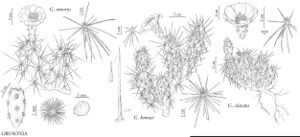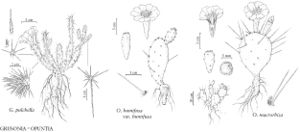Grusonia
Monatsschr. Kakteenk. 6: 177. 1896.
| Taxon | Illustrator ⠉ | |
|---|---|---|
 | Grusonia emoryi Grusonia kunzei Grusonia clavata | John Myers John Myers John Myers |
 | Grusonia pulchella Opuntia humifusa var. humifusa Opuntia macrorhiza | John Myers John Myers John Myers |
Shrubs, usually densely branched, forming mats or clumps [erect or decumbent]. Roots tuberlike and/or diffuse, also often adventitious. Stem segments firmly attached in most species in the flora to easily dislodged, cylindric-clavate, usually curving upward from near bases, sometimes subspheric, subequal in length, glabrous, strongly tuberculate, sometimes appearing ribbed; areoles ± circular, 1–6 mm diam.; wool white, gray, or yellow. Spines with epidermis sheath deciduous at apices only, exposing yellow spine tips; at least 1 of major spines in distal areoles angular-flattened to ribbonlike, sometimes cross-striate, sometimes bulbous-based. Glochids commonly increasing greatly in number with time, in distal areoles, white, yellow, or brown. Flowers bisexual, radially symmetric; inner tepals bright-yellow or rose to purple. Pollen spinulo-punctate, not reticulate (cylindropuntioid type). Fruits yellow to brownish, narrowly obconic to ellipsoid when fertile, fleshy at first, soon drying, smooth, sometimes spiny; areoles bearing conspicuous tuft of long, white to tan wool. Seeds yellowish white or pale-yellow to brownish, suborbicular (to rectangular) or flattened, 3–6 mm, smooth or with rows of raised bumps; funicular girdle encircling seeds, not protruding. x = 11.
Distribution
s United States, n Mexico
Discussion
Species 14 (8 in the flora).
Selected References
Lower Taxa
Key
| 1 | Flowers rose to purple; spines of fruits hairlike, flexible, antrorsely barbed (high magni- fication) | Grusonia pulchella |
| 1 | Flowers yellow; spines of fruits, when present, more rigid, retrorsely barbed | > 2 |
| 2 | Major adaxial spine(s) of distal areoles terete to subterete or absent; shrubs forming mats or clumps; roots tuberlike | > 3 |
| 2 | Major adaxial spines of distal areoles angular-flattened, at least at bases; shrubs forming mats; roots diffuse | > 4 |
| 3 | Major adaxial spine(s) of distal areoles white to brown to black (but not rich red-brown) or absent; longest central abaxial spine commonly twisted or curved, completely chalky white (at least adaxially) except in basal 3 mm or less | Grusonia aggeria |
| 3 | Major adaxial spines of distal areoles rich red-brown (or tan); longest central abaxial spine usually straight, brownish, and cross-banded with interrupted, whitish, wavy lines | Grusonia grahamii |
| 4 | Tubercles very prominent, broad, 1-3.5 times longer than wide, not or little obscured by interlacing spines | > 5 |
| 4 | Tubercles prominent, narrow, 4-6 times longer than wide, obscured by interlacing spines | > 6 |
| 5 | Stem segments 7-19 × 2.5-5 cm; distal tubercles 25-50 mm | Grusonia emoryi |
| 5 | Stem segments (2-)3.5-6.5 × (1.5-)2-3 cm; distal tubercles 8-20 mm | Grusonia schottii |
| 6 | Mature fruits very spiny and glochidiate; plants to 50 cm, in series usually 2-4 stem segments. | Grusonia kunzei |
| 6 | Mature fruits not spiny but glochidiate; plants to 20 cm, in series usually 1-2 stem segments | > 7 |
| 7 | Stem segments 2.5-5(-7.5) cm; distal tubercles 5-10(-16) mm; spines of distal areoles tan or white; longest abaxial spine white, daggerlike, broadly tapered; New Mexico | Grusonia clavata |
| 7 | Stem segments 5-9 cm; distal tubercles 15-25 mm; spines of distal areoles blackish or brown to tan; longest abaxial spine brown to white, narrowly tapered; Arizona, California, Nevada | Grusonia parishii |
"subequal" is not a number.